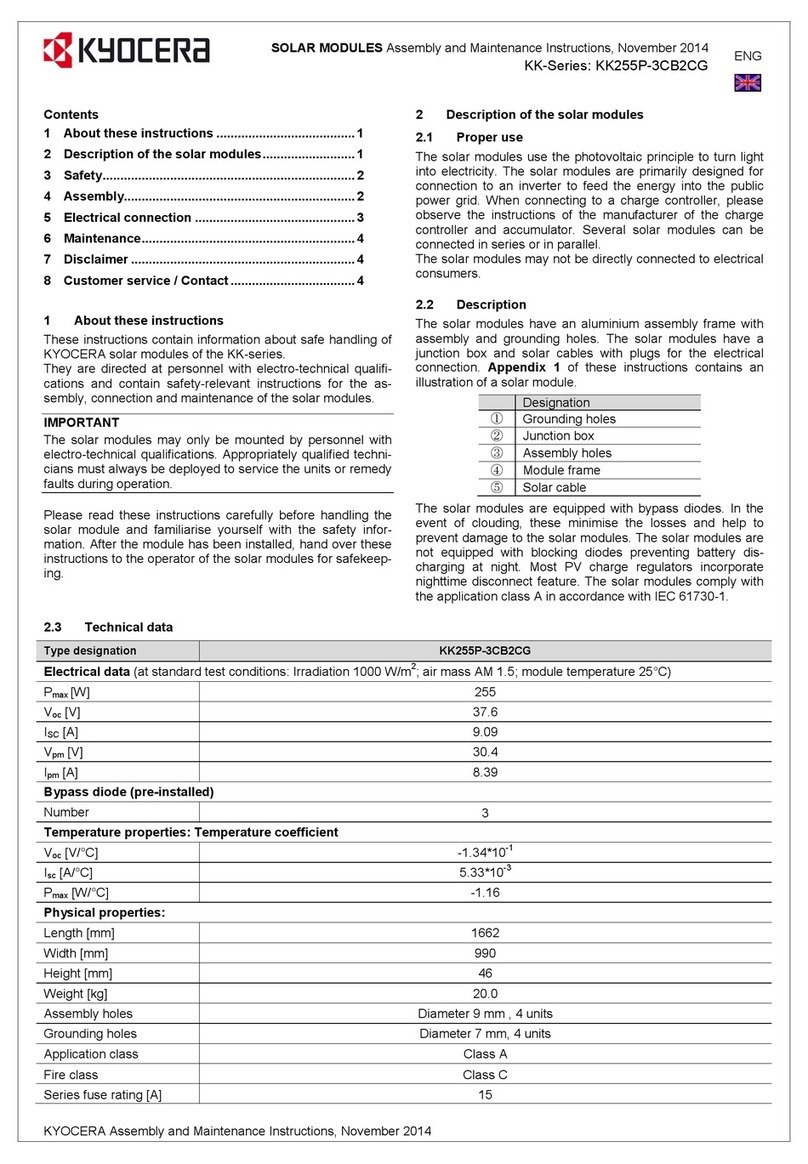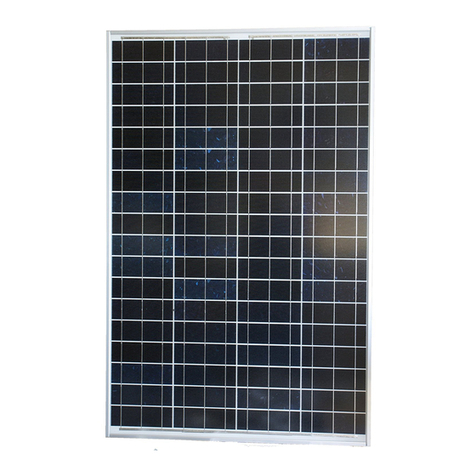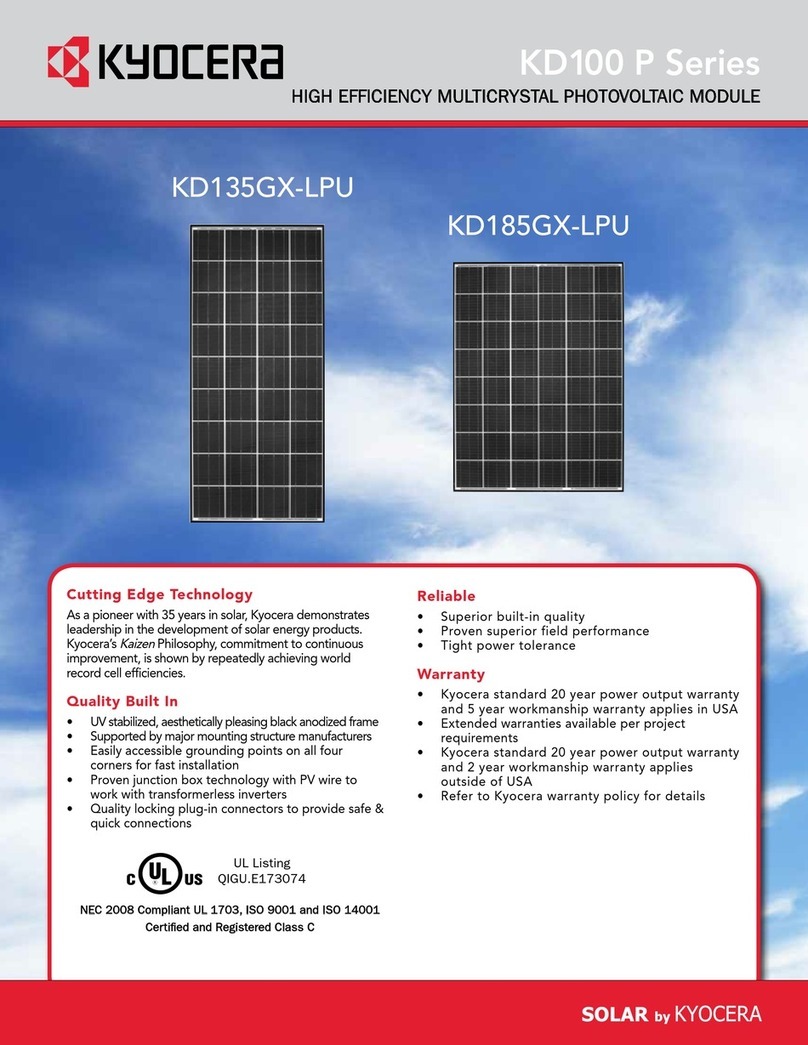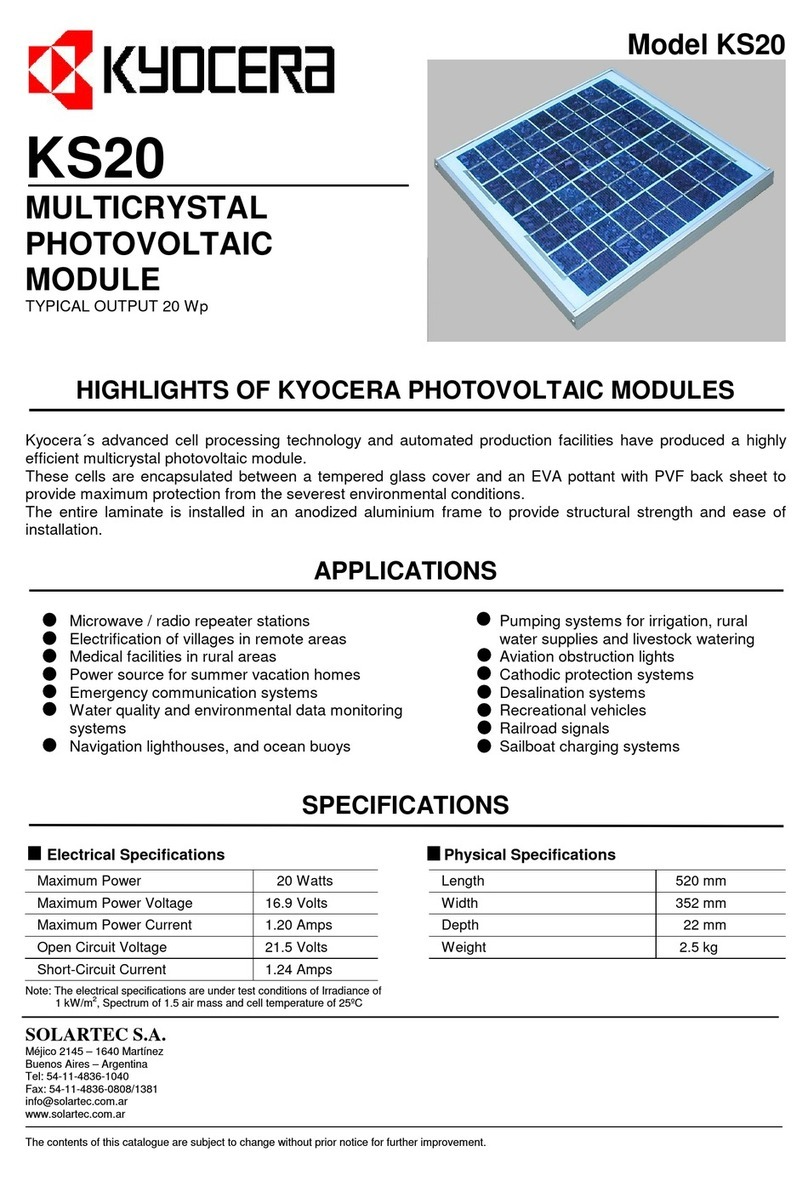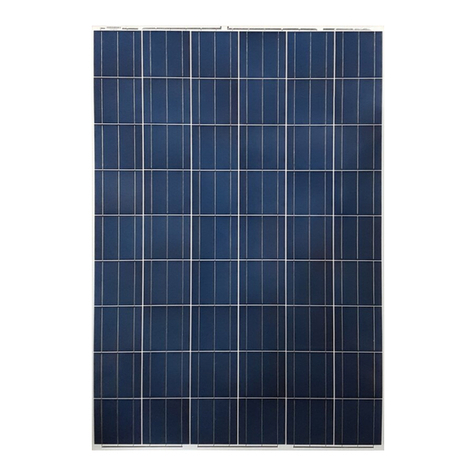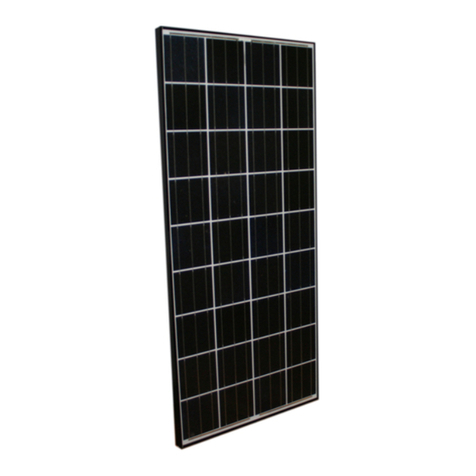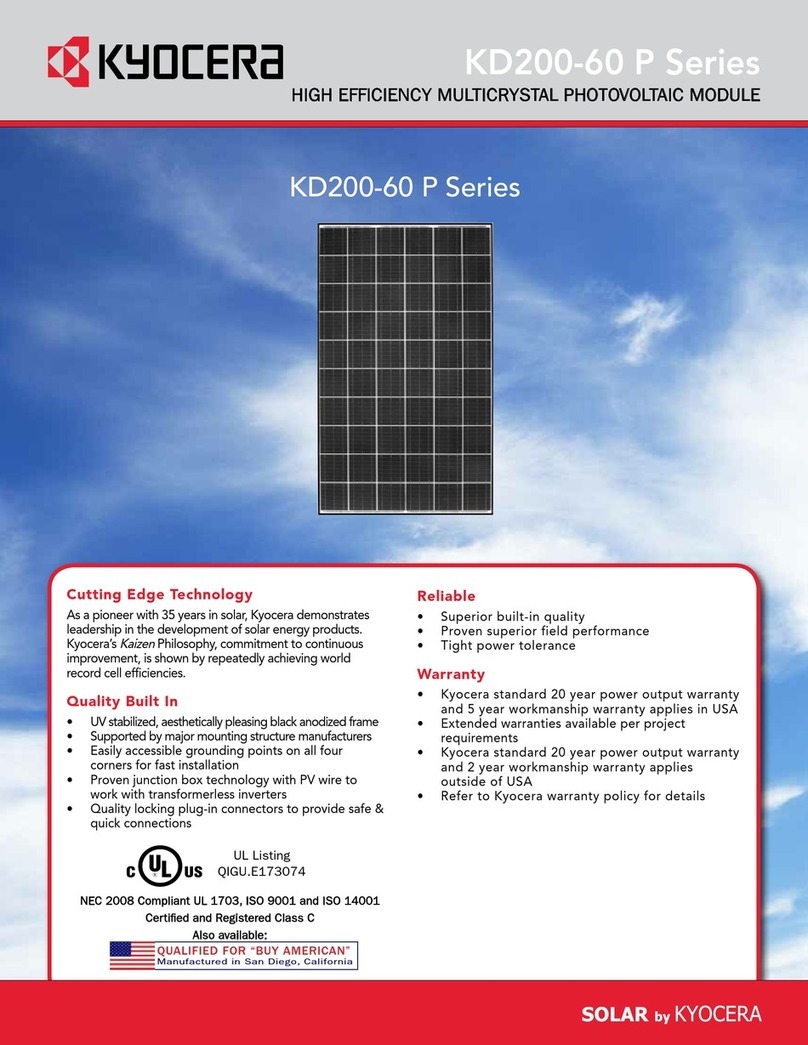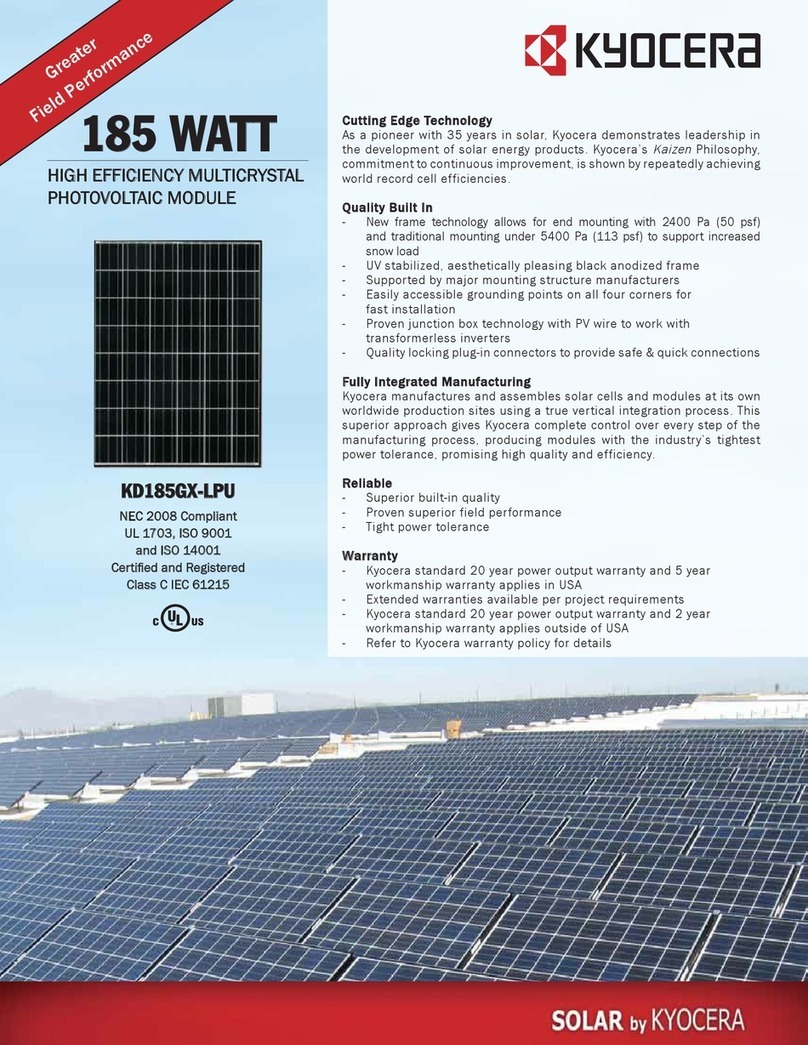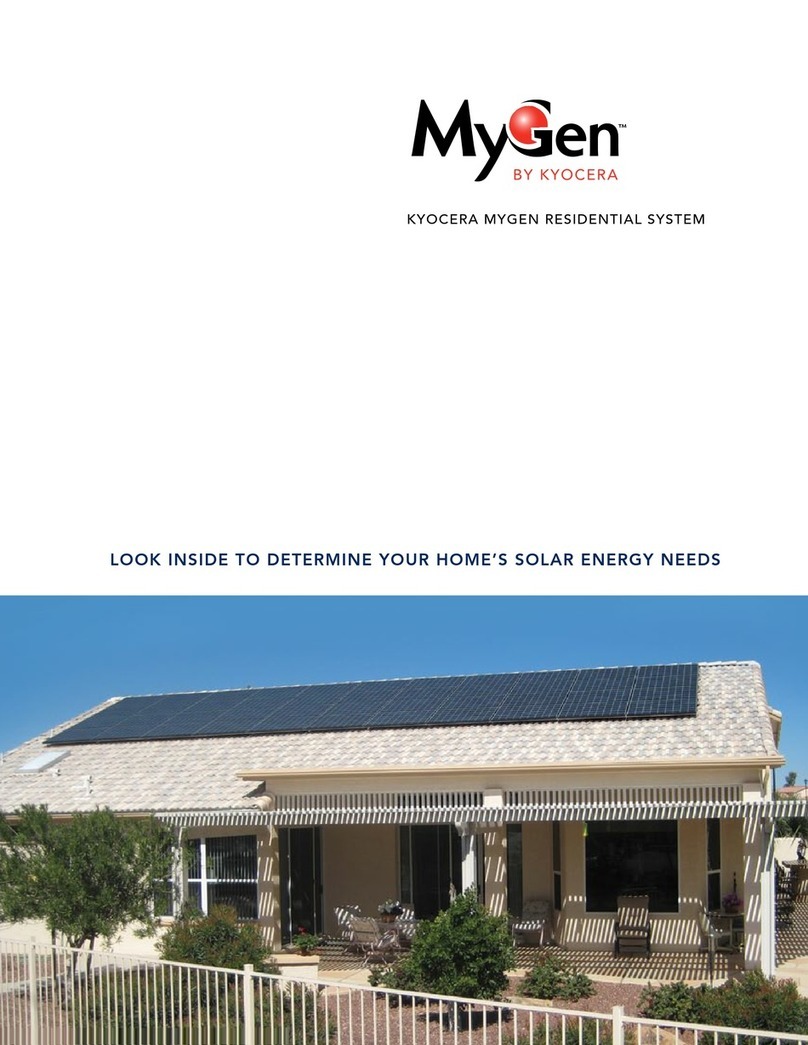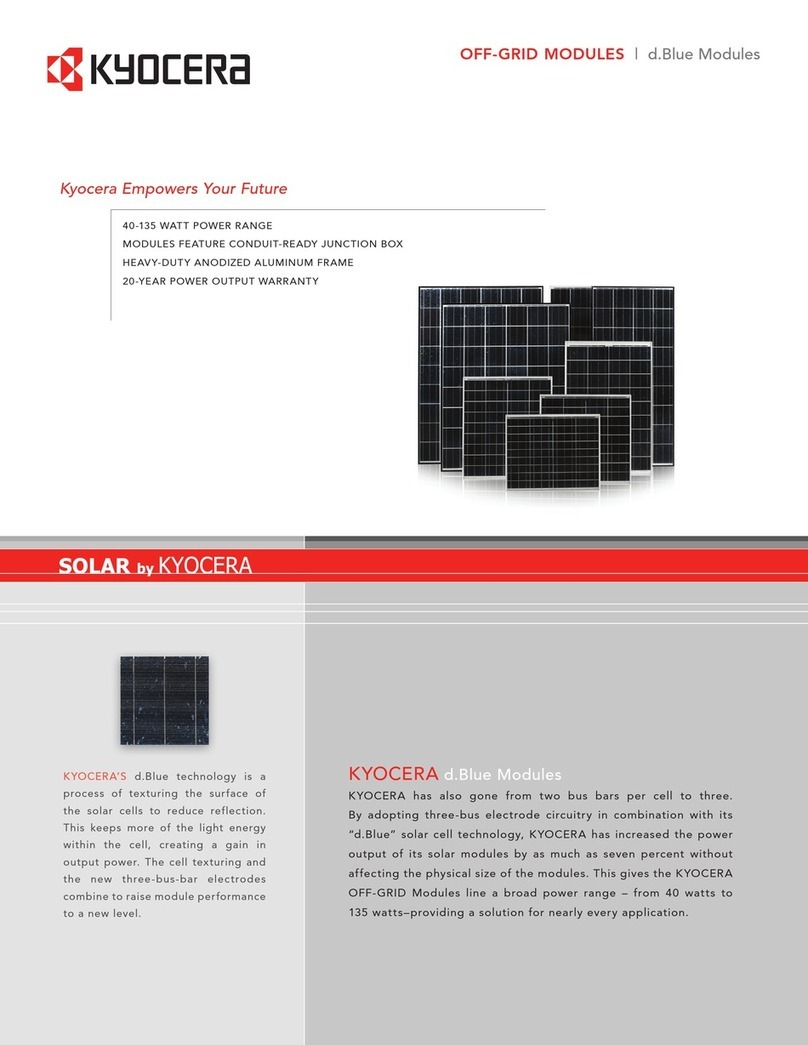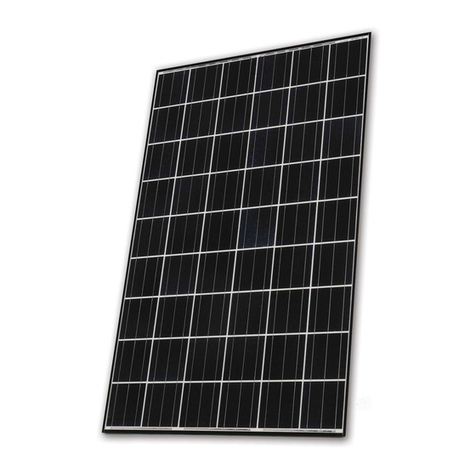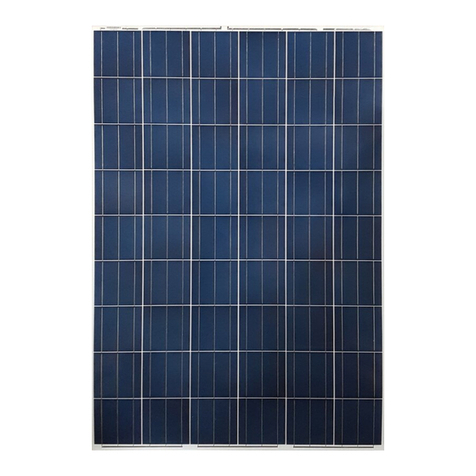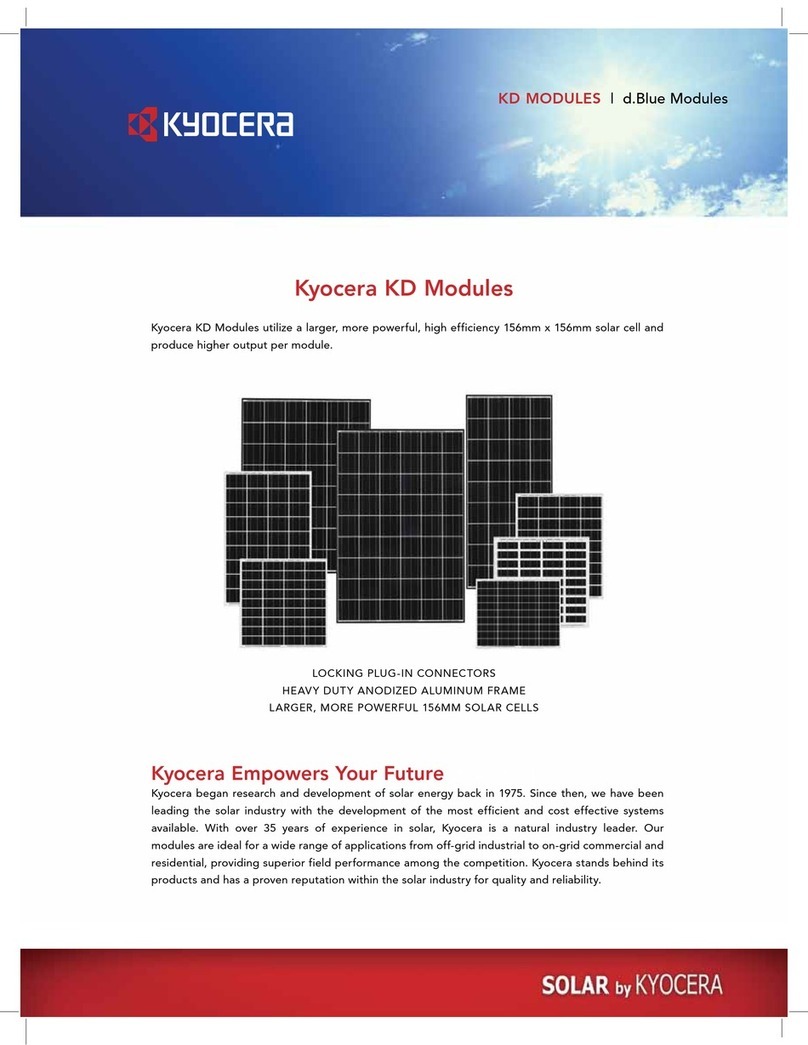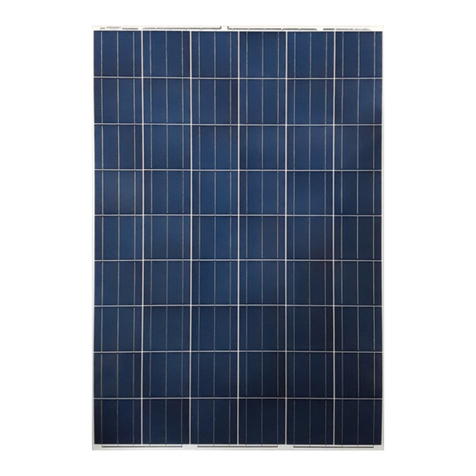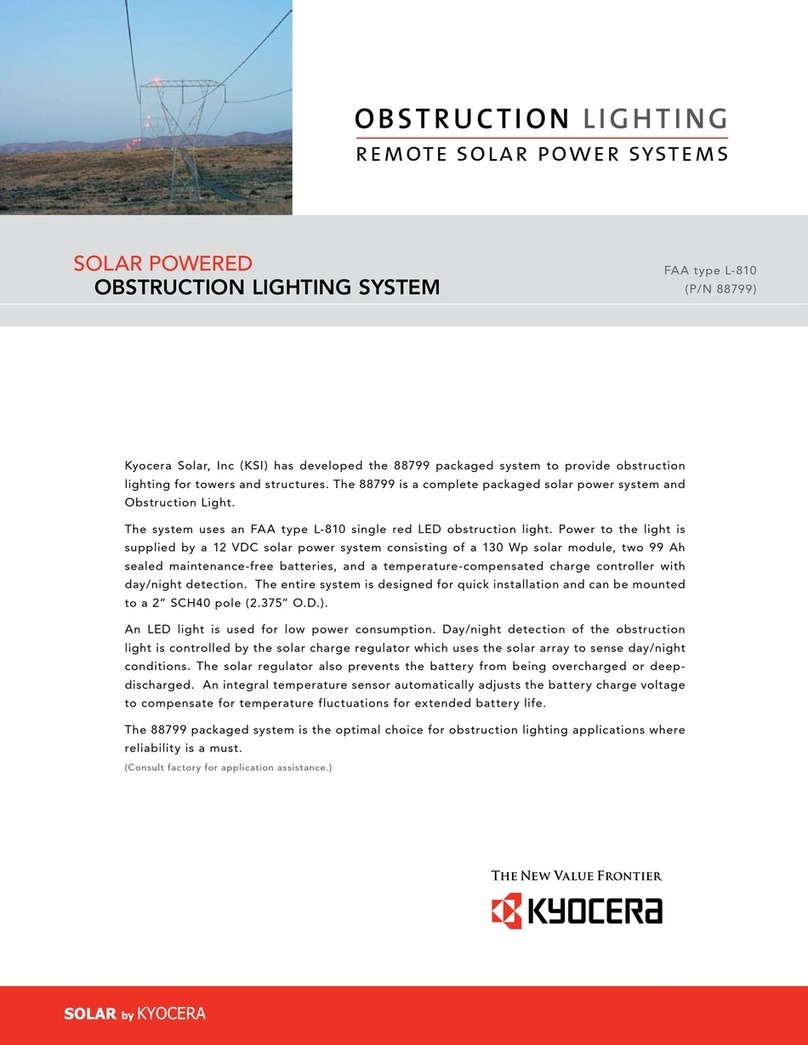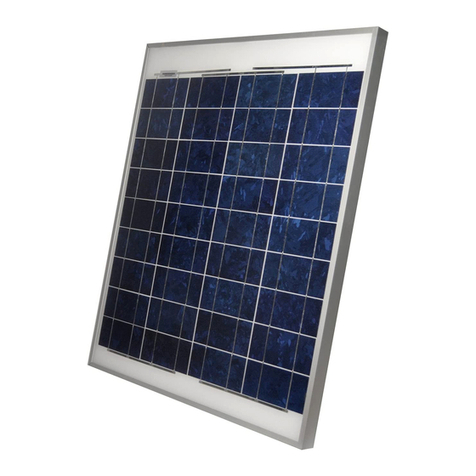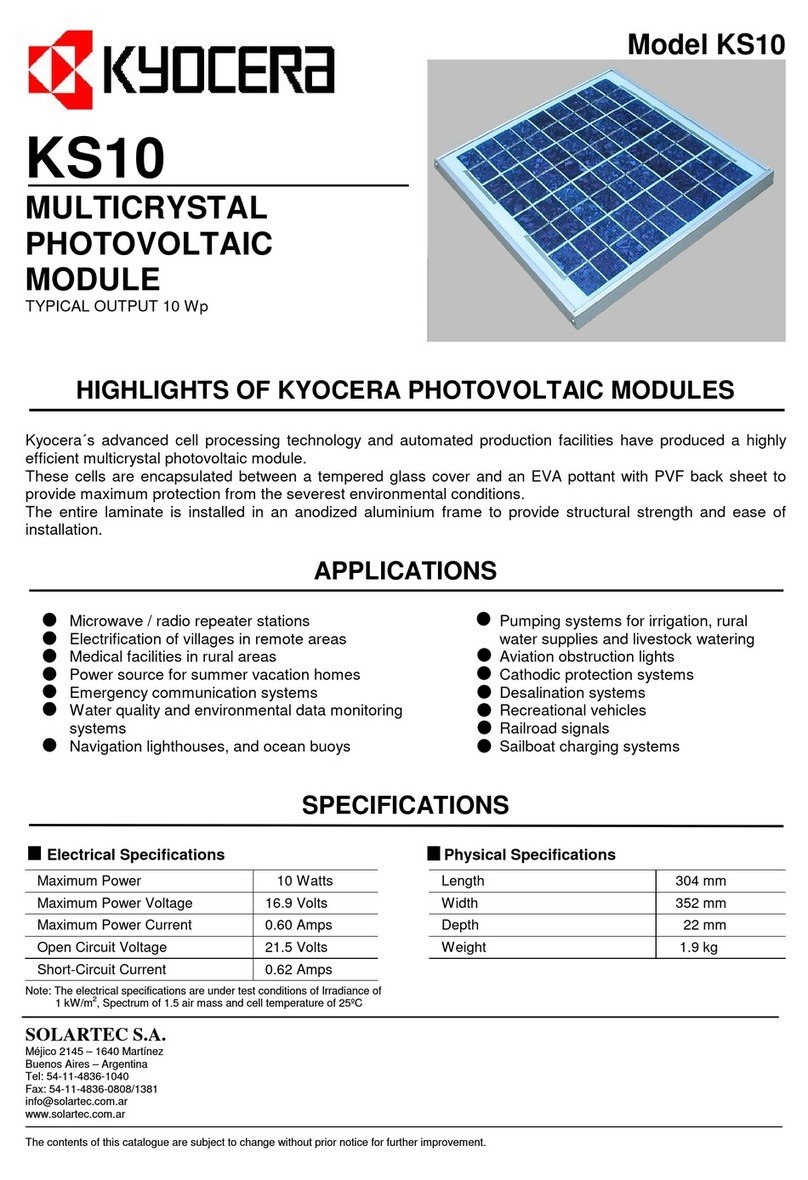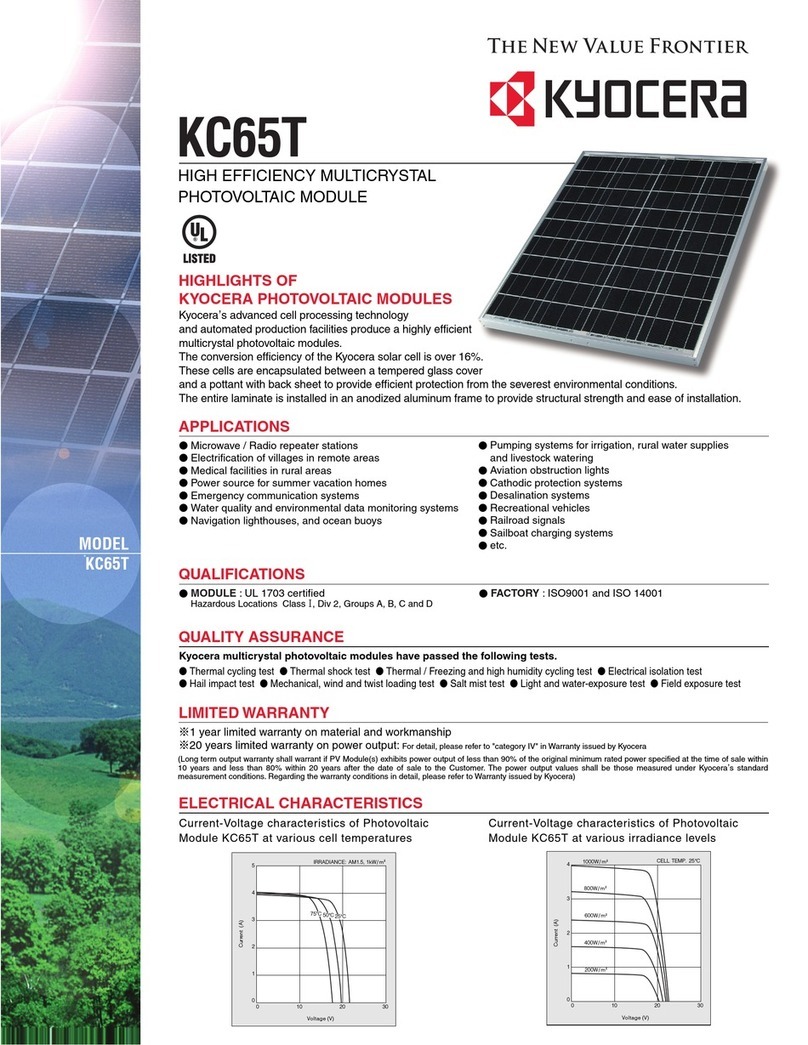
3
NOTE: MAXIMUM SYSTEM VOLTAGE 600VDC.
KD series modules and most PV system com onents have a maximum
system voltage rating of 600 volts DC. Some grid-tie systems o erate
at or near this voltage rating. Like other olycrystalline solar modules,
the o en circuit voltage of the KD series module increases as the
ambient tem erature decreases. Maximum System voltage is
com uted as the sum of the o en-circuit voltage of the
series-connected PV modules for the lowest ex ected ambient
tem erature. Refer to the National Electrical Code Article 690-7(a) for
determining the maximum number of KD series modules that can be
laced
in series. Tem erature coefficients, s ecific to the module of
use, can be used to rovide the most accurate rediction of module
voltage under tem erature extremes.
NOTE: Install the maximum number of series connection for the KD
series PV modules so that the system voltage is less than 600V.
NOTE: In normal conditions, PV modules may roduce bigger current
and/or voltage than re orted in the standard test conditions. Therefore,
when voltage evaluations for com onents, ca acity of conductors, size
of fuses, and size of control systems connected to the module out ut
are determined, multi ly the values of short- circuit current (Isc) and
o en-circuit voltage (Voc) that are marked in KD series modules by the
factor of 1.25. Refer to Section 690-8 of the National Electrical Code for
an additional multi lying factor of 1.25 which may also be a licable.
9. GROUNDING
Before installation, contact the local code authorities to determine the
necessary grounding requirements. Attach all PV module frames to an
earth ground in accordance with the National Electric Code (NEC)
Article 250. Pro er grounding is achieved by connecting PV module
frames and all metallic structural members contiguously to one another
using a suitable grounding conductor. The grounding conductor shall
be of co er, co er alloy or another material suitable for use as an
electrical conductor er NEC. The grounding conductor must then
make a connection to earth using a suitable earth grounding electrode.
Ensure ositive electrical contact through the anodizing on PV module
frame extrusion by utilizing one of the following methods. Attach the
grounding conductor:
(1)to one of the 9mm (0.35”) diameter holes marked “ground” using
5/16” stainless steel hardware. Wra conductor around bolt. Tighten
the screws with adequate torque (usually 132 in-lb). Avoid direct
contact of co er ground conductor to aluminum frame.
(2)to a ground lug (manufacture : ILSCO, model : GBL-4DBT). Tighten
the screws with adequate torque (usually 62 in-lb). Use #10-32
stainless steel hardware to attach the lug to the module frame by the
torque of 40 in-lb. A stainless steel star washer,
ositioned between the lug and the anodized surface of the frame,
must be em loyed to break through the anodized layer of the frame
extrusion and electrically connect the ground lug to the conducting
aluminum frame material.
As a general rule, avoid direct contact of co er or co er alloyed
ground conductors with the aluminum module frame.
All ground bond securing hardware in contact with either the aluminum
module frame and/ or co er or co er alloy ground conductors must
be stainless steel.
Figure 6. Inst ll tion Ex mple of Grounding
10. BLOCKING DIODES
In systems utilizing a battery, blocking diodes are ty ically laced
between the battery and PV module out ut to revent battery from
discharging at night. Kyocera PV modules are made of olycrystalline
cells with high electrical “back flow” resistance to nighttime battery
discharging. As a result, Kyocera PV modules do not contain a
blocking diode when shi ed from the factory. Most PV charge
regulators and inverter incor orate nighttime disconnect feature,
however.
11. BYPASS DIODES
Partial shading of an individual module in a source circuit string
(i.e. two
or more modules connected in series) can cause a reverse voltage
across the shaded cells within the module. Module out ut current is
then forced through the shaded area by the remaining illuminated cells
and other PV modules in series with the artially shaded module(s).
The current forced through the shaded cells within PV module (or
modules) causes additional module heating and severe loss of ower.
The ur ose of by ass diodes is to rovide a low-resistance current
ath around the shaded cells, thereby minimizing PV module heating
and array current losses.
PV modules em loy by ass diodes that have:
・ Rated Average Forward Current [I
F(AV)
] Above maximum system
current at highest PV module o erating tem erature.
・ Rated Re etitive Peak Reverse Voltage [V
RRM
] Above maximum
system voltage at lowest PV module o erating tem erature.
12. MAINTENANCE
Kyocera PV modules are designed for long life and require very little
maintenance. Under most weather conditions, normal rainfall is
sufficient to kee the module glass surface clean. If dirt build-u
becomes excessive, clean the glass surface only with a soft cloth using
mild detergent and water. USE CAUTION WHEN CLEANING THE
BACK SURFACE OF PV MODULE TO AVOID PENETRATING THE
BACK SHEET. PV modules that are mounted flat (0°tilt angle) should
be cleaned more often, as they will not "self clean" as effectively as
modules mounted at a 15°tilt or greater. Once a year, check the
tightness of terminal screws and the general condition of the wiring.
Also, check to be sure that mounting hardware is tight. Loose
connections may result in a damaged PV module or array.
13. SPECIFICATIONS
Under certain conditions, a hotovoltaic module may roduce more
voltage and current than re orted at Standard Test Conditions (STC).
Refer to Section 690 of the National Electrical Code for guidance in
series string sizing and choosing overcurrent rotection.
T ble.2 Kyocer KD Series Module Specific tion
Electric l Ch r cteristics : @ STC
Model Ty e KD135SX-UPU
Rated Power, Watts (Pmax) (W) 135 ±5%
O en Circuit Voltage (Voc) (V) 22.1
Short Circuit Current (Isc) (A) 8.37
Voltage at Load (V m) (V) 17.7
Current at Load (I m) (A) 7.63
Maximum System Voltage 600
Recommended maximum number of PV
modules connected in series 21
Factory installed By ass Diode (Qty) 8
Series Fuse Rating (A) 15
Therm l Ch r cteristics :
Tem . Coefficient of Voc (V / ℃) -0.80x10-1
Tem . Coefficient of Isc (A / ℃) 5.02x10-3
Tem . Coefficient of V m (V / ℃) -9.20x10-2
Physic l Ch r cteristics :
Length, Inches (mm) 59.1 (1500)
Width, Inches (mm) 26.3 (668)
De th (frame), Inches (mm) 1.81 (46)
De th (including j-box), Inches (mm) -
Weight Pounds (kg) 27.6 (12.5)
Mounting Hole Diameter, Inches (mm) 0.35 (9) Qty-4 cs
Grounding Hole Diameter, Inches (mm) 0.35 (9) Qty-4 cs
A lication Class Class A
NOTES
(1) Standard Test Conditions of irradiance of 1000 W/m2,
s ectrum of air mass 1.5, and cell tem erature of 25 deg C.
(2) See module drawing for mounting and grounding hole
locations.
(3) Tolerance of Voc and Isc is +/-10%.
Nut
S ring washer
Flat washer
Ground conductor
Cu washer
Star washer
Aluminum frame
Flat washer
Bolt
Nut
S ring washer
Flat washer
Ground conductor
Cu washer
Star washer
Aluminum frame
Flat washer
Bolt
Nut
S ring washer
Flat washer
Star washer
Ground lug
Bolt
Aluminum
frame
Nut
S ring washer
Flat washer
Star washer
Ground lug
Bolt
Aluminum
frame
